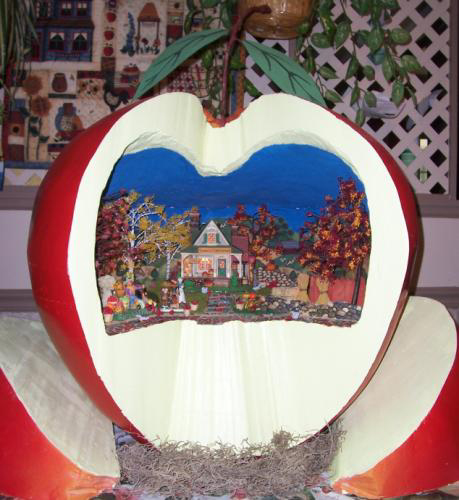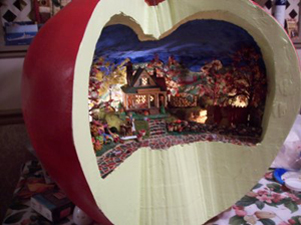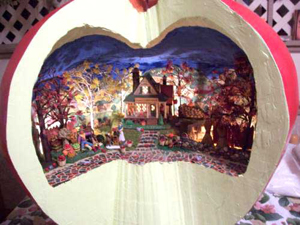Cider House Display
By Pat & John Ehrenreich
Here are some pictures of the apple display we made for Department 56 New England Village Cider House. We had an idea of what we wanted but we really did not have a plan. Most of what follows was made up as we went along:
We had an idea of what we wanted but we really did not have a plan. Most of what follows was made up as we went along:
– A cardboard template of the apple was created that was 28 inches wide and 27 inches tall.
– Pinkboard EPS insulation foam was glued together using the spray adhesive until we had a cube about 30x30x30 inches.
– The Bow Cutter was used for initial shaping with the template pinned to the styrofoam cube.
– After the cutting the right and left side of the cube to the shape of the template, the template was moved 90 degrees and the other two sides were cut. This resulted in a four sided apple. The next step was tricky. We wanted to remove the “corners” of the apple using the Bow Cutter. Since there was no flat surface to pin the template, a sheet rock screw was used to attach the template to the edges of the apple at it’s widest point. Again, cutting the left and right sides to the outline of the template and moving the template 90 degrees and repeating the process. The final result was an eight sided apple.
– Final shaping was done using the Sculpting Tool and Freehand Router until we had the “roundness” of the apple.
– Hard edges that remained were sanded using very fine sandpaper on a sponge.
– Two “slices” were cut from the apple using the Bow Cutter.
– A very thin coat of Foam Coat was rubbed over the surface of the apple and the two slices, using the palm of my hand. This was done primarily to fill in the open seams between the foam layers and the dings and deep cuts that needed to hidden.
– After the Foam Coat dried, the apple was sanded again with very fine sandpaper on a sponge.
– Krylon H2O brand water based spray paint was used for the exterior of the apple. Interior latex house paint was used for the meat of the apple. Water based craft paints were used inside of the cavity.
-Inside the cavity, the cobble-stone road was cut using the Engraving Tool. After the stones were painted and dried, potting sand was brushed into the spaces between the stones. Hair spray was used to hold the sand in place.
– A Department 56 New England series Lit House and accessories and Woodland Scenics’ materials were used to complete the display inside of the cavity. The Two Foot Bow Cutter was a super tool to use for the initial cuts. It was light and easy to handle. If we were to have done anything differently, we would have used the Big Bow Cutter or the size of the styrofoam cube we glued together would have been 24 inches square, resulting in a smaller apple.


